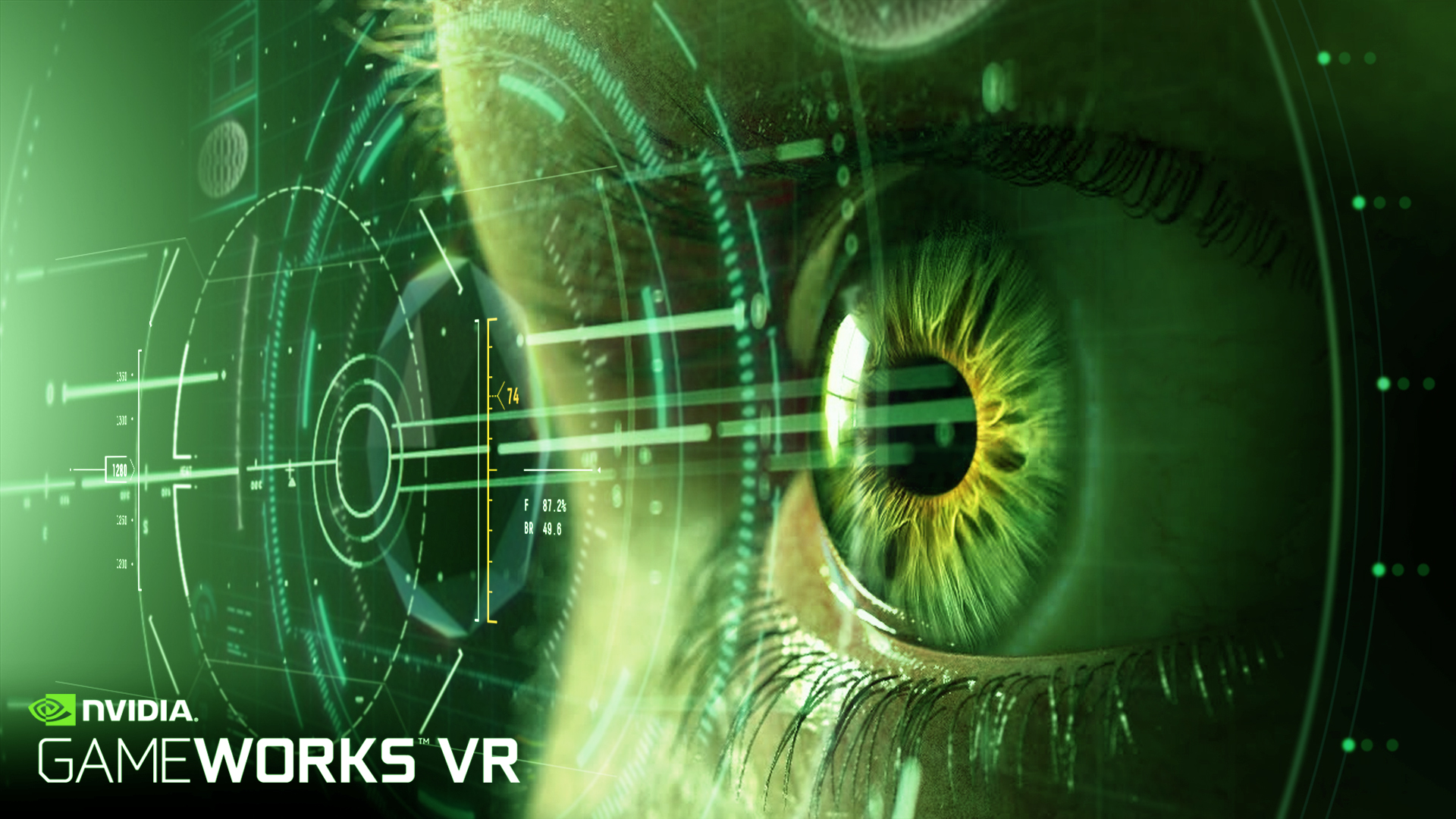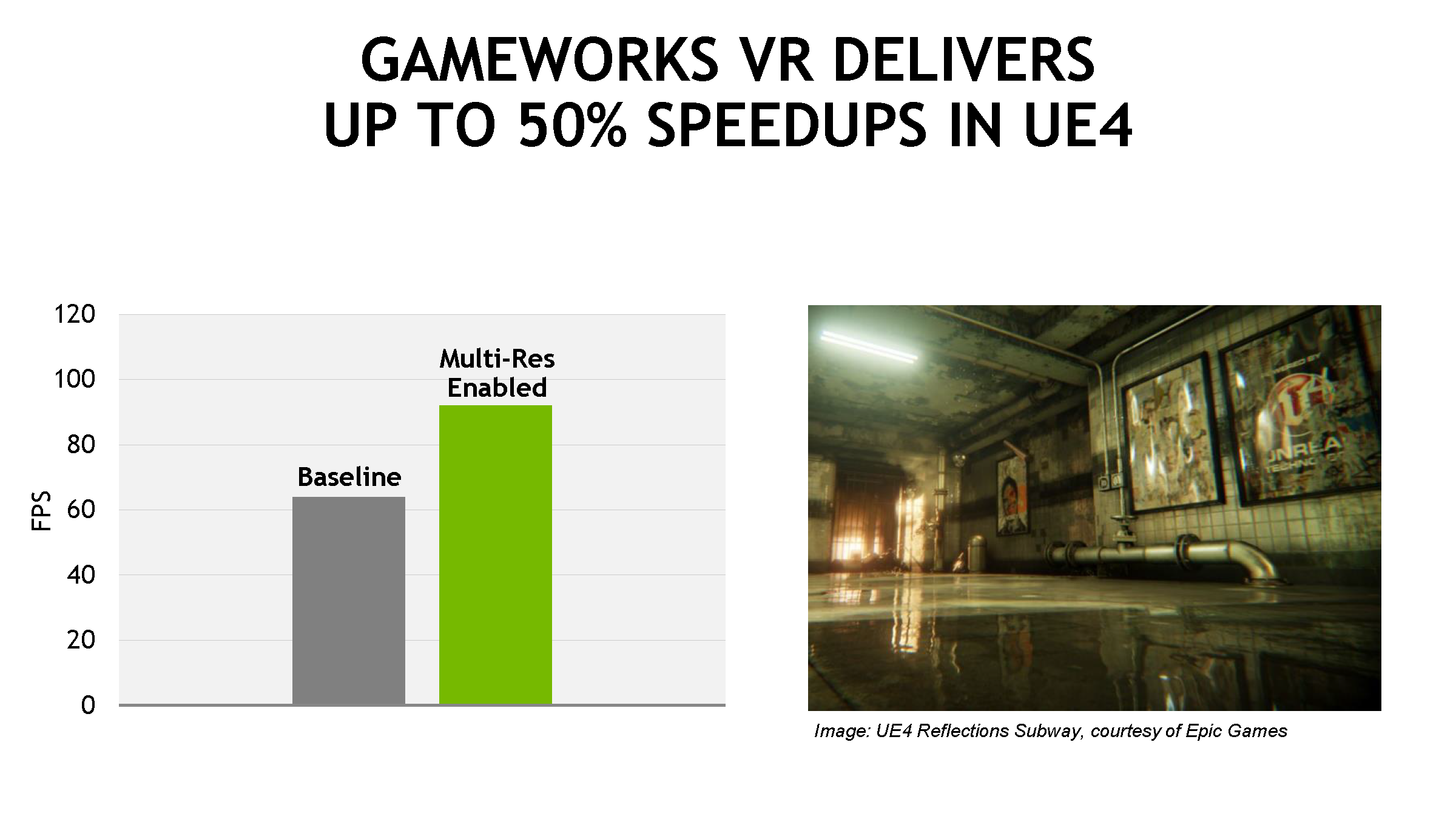Nvidia Announces Gameworks VR Integration Into Unreal Engine 4
VRX is taking place this week in San Francisco, and Nvidia took the opportunity to make an exciting announcement about Gameworks VR and its forthcoming integration into Epic Games' Unreal Engine in the coming months.
When that happens, VR developers using Unreal Engine will have the ability to use Multi-Res Shading as well as VR SLI performance enhancements. Nvidia believes the addition of the integration will rapidly increase adoption of Gameworks VR features.
Some of the features being integrated into the engine are VR SLI, which enables each GPU to handle rendering for a specific eye. Nvidia has also considered systems with more than two GPUs installed by including a GPU Affinity feature that will let VR games scale over the extra processors.
Multi-Res Shading is also part of the Gameworks VR SDK. This is a technique that renders the image in different resolutions depending on the focus. VR lenses warp the image, leaving only the center in focus. Multi-Res Shading takes advantage of this and renders the least in focus areas with less clarity, which Nvidia said improves performance substantially where it counts.
Nvidia said that the company has seen as much as a 50 percent performance improvement in the UE4 Reflections Subway demo when using Multi-Res Shading, but the work on it continues. The company said that integration into the engine is still a couple months away, so final performance improvements could be better than internal tests are showing today.
The version of the Unreal Engine that first sees Gameworks VR integration has yet to be finalized, but the company expects version 4.11 to be the first public release.
Follow Kevin Carbotte @pumcypuhoy. Follow us on Facebook, Google+, RSS, Twitter and YouTube.
Get Tom's Hardware's best news and in-depth reviews, straight to your inbox.
Kevin Carbotte is a contributing writer for Tom's Hardware who primarily covers VR and AR hardware. He has been writing for us for more than four years.
-
garrlker I don't know why they're being downvoted, it's true.Reply
GameWorks is doing nothing but trying to make the competitions GPUs perform worse. -
photonboy The Gameworks issue is complicated.Reply
NVidia adds features that others don't (or can't) then get flamed by people for being proprietary.
Just like GSYNC. Just like PHYSX. (although code for Gameworks can work on AMD GPU's)
*So what exactly would be BETTER about gaming if NVidia didn't create Gameworks?
(I know there's been complaints about NVidia intentionally crippling AMD GPU's though from my investigation there is no truth to that such as the tessellation issue for Witcher 3 which AMD whined about then managed to fix in just two weeks with parity to NVidia performance) -
monsta I'm with you there photonboy, anything Nvidia does or create gets flamed here, if on the other hand it was created by AMD it gets nothing but praise.Reply -
photonboy Reply16927527 said:I'm with you there photonboy, anything Nvidia does or create gets flamed here, if on the other hand it was created by AMD it gets nothing but praise.
Yeah, and while people say "proprietary sucks" I have to ask why then would NVidia do something and give it away for FREE so AMD benefits too?
I don't like having proprietary features and sure I'd love it to be all luvvy duvvy open source etc, but then AMD has to pull their weight too.
I just got so burned up when AMD kept constantly going after NVidia (and lying outright at times such as when discussing GSYNC vs FREESYNC).
My biggest peeve was when they worked on Mantle and said that NVidia would be able to work with it too. Open source right? No problem? Nope... they admitted they wanted to RETAIN CONTROL over it indefinitely thus they could tweak it to optimize to their hardware (even in advance of new GPU's).
Wasn't this control thing their major complaint about NVidia's "black box" Gameworks software because they didn't control it and thus NVidia could supposedly optimize it for their GPU's? -
Christopher1 The point is that Nvidia and AMD are a duopoly. In order to have proper competition both have to have access to the same technology and same standards so that means when Nvidia makes something new, AMD should have access to it so that they can support it too.Reply
The inverse situation also meets that standard. -
AeroWB Wow photonboy, why I do agree with you that gameworks is not only bad and discussing it's use is more complicated, but it does look like you are blinded by your green love.Reply
The fact is that NVIDIA has more marketshare and more money that AMD and they are clearly using that advantage to push AMD further down. Which is very bad for us consumers because we want freedom of choice when we buy a new GPU. All vendor lock-in is bad no matter who does it.
The only two potential vendor lock-ins from AMD we have seen the last couple of years are Mantle and TressFX. AMD has told everyone that it was going to be open Mantle technology but that they wanted to keep control over it in the beginning as that was more efficient. Mantle now is deprecated as most of its technology is now included into the successor of OpenGL: Vulcan. So AMD's technology is now actually open for anyone including Nvidia. The first version of TressFX worked only well for AMD GPU's but TressFX has been open-source from the beginning. Nvidia or anyone else could have easily added to that. But with the next version AMD made it so that it works just as well on AMD as on Nvidia cards, it is even slightly faster than Nvidia's Hairworks on Nvidia GPU's.
Nvidia on the other hand has done many vendor lockins or released tech that can run on AMD but runs badly.
1) CUDA, Nvidia only, luckily with OpenCL and DirectCompute alternatives exist but the fact is that CUDA is and was Nvidia only
2) PhysX, while Nvidia does have a CPU path that is single core only for those without an Nvida GPU it intentionally cripples performance. When Nvidia just purchased PhysX and ported it to run on their GPU (instead of the Ageia card) People with AMD cards could purchase a second GPU of Nvidia to run PhysX on that, but Nvidia disabled this in later drivers so only if your main GPU is Nvidia can you accelerate this, just pathetic and bad for gamers.
3) G-Sync, luckily AMD launched a standard open technology alternative with FreeSync, G-Sync is another vendor lock-in, tech and alway will be.
4) GameWorks, while I can see the benefit of giving game developers access to code that makes it easier for them to use new graphics technology, Nvidia clearly intends of giving this tech only to Nvidia GPU owners. Some of it does run on AMD GPU's (HairWorks) but not very well. GameWorks is not open source and therefore AMD cannot add optimized code-paths for their GPU's even if they wanted to. Game developers can pay Nvidia to get the source code, so they could add an optimized code path for AMD GPU's but that is very unlikely as A) that code needs to be adjusted again and again for each new gameworks release as its not going into the original source, B) the fact that a game dev is using gameworks instead of making something themselves means its very unlike like they have the time/skill/resources of fixing it on AMD cards. GameWorks therefore becomes in practice another item on the long list of Nvidia vendor lock-in tech.
While what NVidia does is not illegal or bad in it self, the only advantage of their policy is to their own wallets. For consumers like us vendor lock-in is always bad as you loose the freedom (or at least it becomes very hard) to choose any other vendor. And so instead of buying the best performing card at a specific price, you must choose the Nvidia one otherwise you loose CUDA/GSYNC/PhysX and Gameworks
Another problem is that game developers do not choose the best technology for the job. If they are sponsered by Nvidia they will use HairWorks instead of TressFX while for all gamers TressFX would have been the better choice. Its just politics. So what we as consumers need are new open standards technologies that will allow us new and better technology without loosing our freedom of choice.
As it is right now AMD is the good-guy and Nvidia the bad-guy, thats just a fact. It could very well be that if AMD was the bigger one the roles would be swapped, who knows. Personally I can still understand if someone buys a Nvidia GPU but I am worried that in the future we have to pay more for our GPU's while getting less improvements as these vendor lock-ins destroy the free market where there are only two players left right now. -
rwayne I have no problem with one company or the other offering proprietary graphic features for a game but I have a MAJOR problem when that proprietary technology impacts the other company's products in a negative way. It is unfair to consumers who buy the game.Reply -
photonboy AeroWB,Reply
I'm not blinded by "green love" at all. In fact, I'm a bit annoyed about the split in features.
As for Mantle, well I had a link to AMD saying they wanted to retain control INDEFINITELY not just the short term so you're wrong there.
(not just a link but a VIDEO of one of the AMD guys talking... forget his name but he was asked specifically about the "open source" of Mantle and had to answer)
GSYNC:
Here's a prime example of NVidia introducing functionality that only BENEFITED from what existed before. In other words, if they didn't come up with it then we'd simply have the same synchronous monitor technology as before.
So, what was NVidia supposed to do there? It took millions of dollars so should they just give the technology away for free?
I suppose NVidia could have been really nice and said to AMD "hey, we'll SPLIT the cost of research so we can make these work for both AMD and NVidia" but frankly I doubt AMD could have coughed up the coin to do that.
(I also did say it was a complicated issue so obviously I wasn't fully discussing every point like Gameworks which is obviously a bit trickier)

